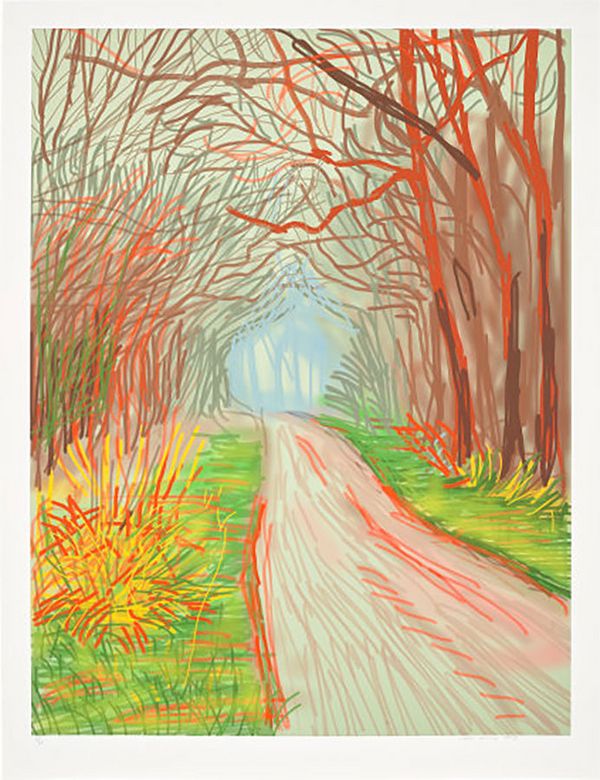David Hockney, The Arrival of Spring in Woldgate, East Yorkshire in 2011 (twenty eleven) - 13 January. Editions London. To view lot, click here >
The Arrival of Spring, Woldgate is David Hockney’s series of 61 iPad drawings capturing the small, gradual changes of the seasons from the bare ruined choirs of winter at the 1st of the new year, 2011 to early summer blossoms on the last of May.
To be sure, simply stated, that is the artist’s subject, as he has often said. But there is much more going on here — including much that is implicit and left unsaid.
By Don Carroll, with Jonathan Keep
I point landscape designer Jonathan Keep to the Woldgate series, without telling him what they are. “Do these look particularly English to you?” I ask. They do to me, as English as a proper cup of tea.
High tea in the Rose Parlor had been the high point of our undergraduate existence together as budding art historians at Vassar years ago, when vestiges of English Ivy still clung to the historic Hudson River Gothic Revival buildings.
“Well,” he says, upon reflection, “They don’t look like Sir Joshua Reynolds, Gainsborough or Turner, if that’s what you mean. Maybe a little bit of Constable in the naturalism… But, what’s more English than Hockney?” he chuckles. He knew.
“Yes, more English than the lot of them, isn’t he?”
“Exactly.”
“He was always English,” I say. “But he didn’t use to show it so much. Then again, he did feature in the 2004 Whitney Biennial — doesn’t that make him American? It’s not so much a matter of birth. And hasn’t he always been the official artist of Los Angeles?
“He is LA, yes” Jonathan agrees, “and LA is him.”
When Hockney moved back to Yorkshire after his mother died in 1999, I was aghast. It felt as incongruous as moving the London Bridge from the mighty Thames to Lake Havasu in Arizona (which someone actually did!).
As Carol Kino noted in The New York Times in 2009, many initially saw Hockney’s return to Yorkshire to paint landscapes as a retrograde retreat into nostalgia. Even locals allegedly mistook him at first as some random Sunday painter.
Little did we know then…
The move was to signal a profound personal Renaissance for the artist of truly gargantuan proportions — more heartfelt, intimate, and commanding even than all his many previous achievements.
This became abundantly clear with his 2012 exhibition, A Bigger Picture at the Royal Academy. It was not only the hit of the season in London and the most popular show in the history of that great institution — reverberations were also heard round the world.
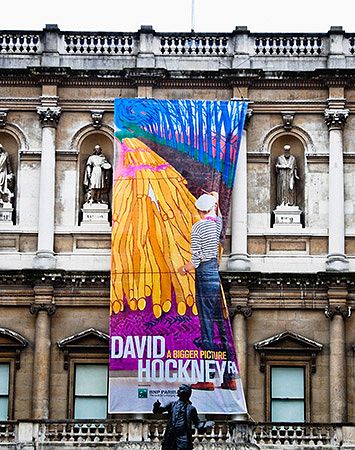
Mark Bolton Photography / Alamy Stock Photo
After that, no one would ever think of English landscape in the same way again. He had effectively rebranded England in the eyes of the world, just as surely as he had done for LA with his iconic swimming pools decades earlier.
“They’re calling him French now,” Jonathan jabbed.
“Please don’t get me started.”
Note: Sadly, the artist permanently withdrew from seaside town of Bridlington in the East Riding to Normandy in 2019 after the tragic suicide of his young assistant — although he casually jokes it also had to do with their more permissive attitudes toward smoking and other Bohemian behaviors. But that, of course, is far from the end of the story…
A CLOSER LOOK AT HOCKNEY
“It could almost be New England,” Jonathan says. “That’s what I know best. The species are similar. On further inspection, though, yes, you are right, from what I can make out those plants appear to be native and characteristic of that part of Yorkshire in particular. They are very typical.”
“Different species exist in the overstory, canopy, understory, shrub layer, and ground level. This looks to be an ash woodland — very typical of the Yorkshire Wolds. The canopy is impressive. I see a pointed arch. Very natural. Very regal.”
“Hockney calls it his ‘tunnel.’ It’s one of his favorite subjects in the Wolds. Make of that what you will.”
“I’m guessing that shrubby clump in the foreground must be Tilia. It’s really a tree — Americans call it Linden and Brits, a lime — but people in England forage and coppice it, so you get that profusion of red twigs. In the States, a designer might use Red Twig Dogwood for the same effect, gorgeous especially in winter when all the leaves fall away. But here, the look is probably incidental. That’s how gardeners think. And painters perhaps, but not woodsmen.”
Coppicing, once common, means lopping off the trunk of a mature tree to induce the stump to sprout a thicket of shoots, which are better suited for firewood and for making poles and handles for tools and chair legs.
“I’ve heard that farmers in the Wolds can also be attentive to concerns like that. But, yeah, they probably didn’t do it just to get a flash of red.”
“We gardeners also love that brittle texture to play against the softness of herbaceous plants — that means there’s no wood in the stems — mainly grasses. Color and texture are everything these days.”

David Hockney, The Arrival of Spring in Woldgate, East Yorkshire in 2011 (twenty eleven) - 31 May, No. 2. Editions London. To view lot, click here >
“The traditional chalk grassland was once the predominant mosaic vegetation here,” Jonathon tells me. “There was a diverse array of wild scrub grasses, ideal for pasture. It’s mostly gone now.”
From more than 70% down to 1.3%. And many of the hedges were cut down to make it easier to use modern farming machines on the fields.
“But on the roadside verges, the past survives. Those are the species I’m seeing.”
“That’s not a black-top asphalt road?” he asks.
“Good point, I don’t think it is. I’ve seen photos of it — a light gray, almost neutral in temperature. Hockney’s pulling the color from what he’s looking at. When you look hard enough, the colors start to interact on your retina. That pavement is so softly spoken in reality, I can imagine it drifting into pink in reaction to all those powerful greens as things take off in May.”
“The pink road is so now. Hot pink in 2022 was the color of the year, especially on the runway… Valentino, not to mention Barbiecore. But in the past at times a pink road meant a spiritual journey,” Jonathan says.
“That could be there, yes. But maybe not so literally. However, I do see it as representing a journey, no doubt.”
Hockney spoke a great deal about movement in the time leading up to these pictures. He was talking on one level about the motion of the eye through a scene (as distinct from the planted lens of photography), which he got from looking at Japanese watercolors.
A big influence on Hockney’s works in the “Yorkshire Wolds” is Chinese landscapes, particularly the scholar tradition, so admired by Taiga and other masters of the Bunjinga (Nanga) school of painting in Edo Japan (1603–1869). The Cultivated Landscapes show at New York’s Metropolitan Museum had a big impact on him in 2002. On the one hand, it jived perfectly with conceptions of movement and space he’d been exploring for more than a decade. On the other, it offered him a deeper connection to the landscape, bringing eye, heart, and hand together in a single image to capture the personality of a landscape — as though it is the portrait of a place at a very specific moment in time.
It’s an England I know that’s hardly changed. It changes every day, even by the hour.
—Hockney
“Note the artist’s vertical portrait format — which is in itself a radical move, something you almost never see in landscapes. One must remember he was at this juncture concurrently working on a large volume of portraits. In both cases, he is obsessed with looking and noticing the differences, from one to another.”
For Hockney, what is seen is largely informed by familiarity.
Importantly, in the The Bigger Picture documentary, directed by Bruno Wollheim for the BBC in 2009, Hockney says, "We always see with memory. Each person’s memory is different. We can’t be looking at the same thing. It’s somebody looking at it… Are there any empty landscapes? Do we know what an empty room looks like?"
But there is also more to the Japanese connection here. He also journeys out each day, as they had done, to meet nature and bring it home. Among the first things he did upon resettling in these parts was to fill accordion-fold, multi-panel sketchbooks (like Japanese screens) with endless sketches of the many different grasses he encountered in the hedges. He was building a familiarity he would later reference to great effect.
“He’s quite insistent on that road, though, isn’t he? It’s life that interests him in the here and now — a life journey, as well, perhaps. That these paths drift to the left is, I think, important — that would be back into the past.”
One cannot help but see here nature’s recurrent cycle of life and death and a deep reflection on mortality and rebirth.
I presently redirect Jonathan, “I’m interested particularly in the English landscape garden tradition. Not so much Turner and Constable.”

David Hockney, The Arrival of Spring in Woldgate, East Yorkshire in 2011 (twenty eleven) - 18 January. Editions London. To view lot, click here >
“There is that prominent stump, formally known in the industry as ‘an eyecatcher,’ which reminds me of the traditional landscape garden folly. In the late 18th century, it might have been the ‘fake’ ruins of an old castle to evoke the ancient past.”
Hockney calls that stump his “Fetish,” and it is a recurrent point of focus throughout his Wolds oeuvre. One can’t help imagining it as a stand-in for himself, on some level, given its relative maturity. Trees of that girth are veterans.
“The land in England is a palimpsest,” Jonathan says, “with the trace of history often apparent — or just beneath the surface. It’s more than just the scattering of artifacts. Humans have transformed the very ecology of their island. Behind the bring back the hedgerow movement is the idea that humans can work in partnership with nature to create complex ecosystems.”
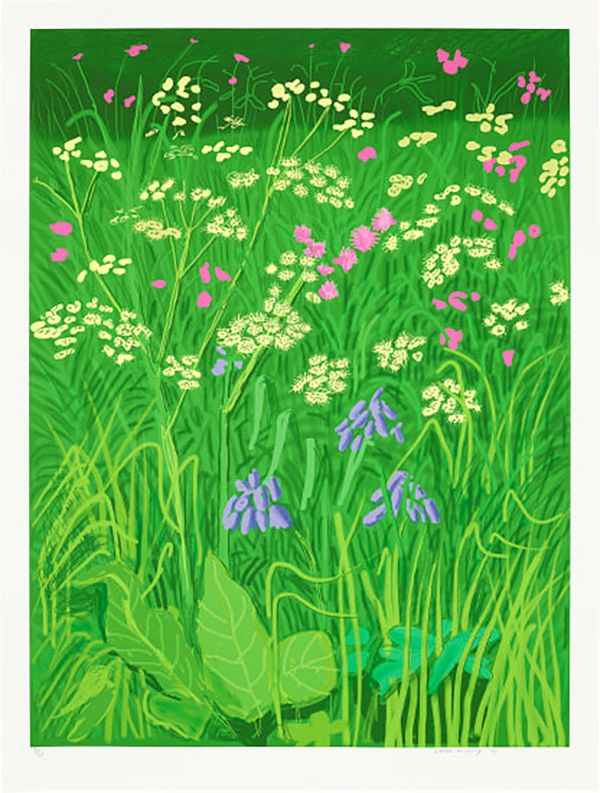
David Hockney, The Arrival of Spring in Woldgate, East Yorkshire in 2011 (twenty eleven) - 17 May. Editions London. To view lot, click here >
“Many species of roadside wildflowers, for example, that are now typical only gained prominence owing to age-old farming practices. If the farms went away, many of these ‘wild plants’ would likely dwindle in large numbers. And the English know this almost instinctively. By the way, in gardening parlance, that burst of spring ephemerals is known as ‘an enameled mead.’ That’s short for meadow.”
"That's definitely bluebells. The others are trickier — Pignut...? No, I'm thinking Red Campion and Queen Anne's Lace. The three often spring up together all over the roadsides of England this time of year, especially coastal East Yorkshire."
"Bluebells are said to be protected by fairies," I say. "You're not supposed to pick them."
"It's also one of the wildflower species protected by the government," Jonathan laughs, "and it's against the law."
"We've also got Queen Anne's Lace in the States," I say.
"In England, it's indigenous."
"It was said that Queen Anne and her Ladies were so lovely that as she toured the countryside, it burst into flower to welcome her. Thus the name."
"It's also called Cow Parsely," Jonathan laughs. "It's a very English flower, like Guelder Rose or Elder, which are hedge row shrubs."
“Even the forests in England are managed,” he continues, “and have been since Medieval times when coppicing and pollarding were common practices. These traditional crafts — including things like growing and pruning hedges and scything instead of using a mower — are now all coming back into fashion, a little bit as they did in the Arts and Crafts Movement a hundred years ago, but on an even bigger scale. It was always coppicing that broke open the canopy to allow patches of sunlight for wildflowers.”
THE ENGLISHNESS OF THE ENGLISH LANDSCAPE
Not so long ago, to be English meant being a member of the most exclusive club in the world. And everyone felt it. This is no longer the case. Postwar Britain is racially, ethnically and culturally diverse. And patriotism is increasingly unfashionable, particularly on the Left and among young people. Fewer than one in two 18–24-year-olds are proud to be English, according to the The English Question survey (BBC), which is the largest of its kind. The same for residents of all ages in London, Oxford, and Cambridge — with only 32–45% strongly identifying with being English. However, Englishness is still very much a thing the further you get from London — and even globally. After Hockney, it is once again more relevant than ever.
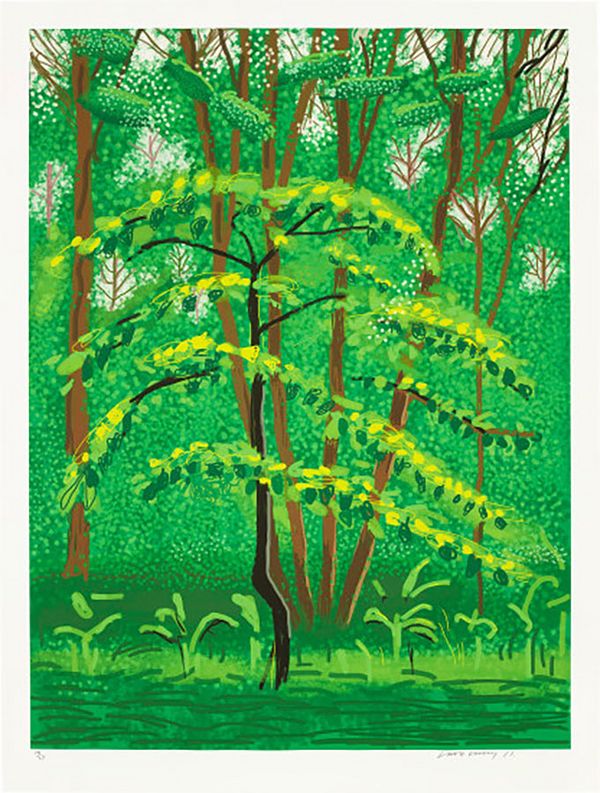
David Hockney, The Arrival of Spring in Woldgate, East Yorkshire in 2011 (twenty eleven) - 19 May. Editions London. To view lot, click here >
Back in the 1950s, architectural historian Nicholas Pevsner was among the most learned of all British writers on art and culture. In The Englishness of English Art, he famously asserts that the landscape garden has been Britain’s Greatest contribution to the visual arts. That is to say, landscape painting is its mere appendage.
“It's fair to say that Hockney has singlehandedly reinvented the English landscape painting genre,” I say, "epsecially in this series... But maybe it's even bigger than that..."
"It's like he's promoting an entirely different vision of the English landscape garden we've never seen before — not like this," Jonathan concurs.
"So let's talk about the garden — what are those plants?"
"For a moment I thought it might be Hazel... But I see Yellow Hawthorn here. It's a thorny flowering and fruiting plant, the most common hedging staple in England — in woodland wilds, they're both understory plants."
"That would make sense. Hockney loves to see the Hawthorns in bloom. Are they wild plants?"
“England is a garden. Nothing is wild.”
Our England is a garden that is full of stately views,
Of borders, beds and shrubberies and lawns and avenues,
With statues on the terraces and peacocks strutting by;
But the Glory of the Garden lies in more than meets the eye.
—First stanza of Rudyard Kipling’s “The Glory of the Garden,” 1911
“Not to mention,” he chimes in, “England is a nation of gardeners.”
BBC Radio’s “Gardening Question Time” hit the airwaves in 1947 and is way bigger than NPR’s “Car Talk” in the States. The Chelsea Flower Show put on by the Royal Horticulture Society every year — arguably only a close second to Christmas — is a spectacle of chatter and debate from all levels of society about the latest trends. There is nothing like it in the States. Nor is it just about people’s favorite flowers.
“The average American tends to think of a garden as a small patch of vegetables or flowers set off on its own. Their lawn is a distinct entity. Not so with the British. The scope of their interest encompasses the entirety of the landscape, including woodlands.”
“For Kipling,” I say, “that also includes pastures and arable farmlands. They’re the beating heart of the country.”
“It was a nationalistic poem, really about the British Empire during its heyday,” he says. “But, yes, those ubiquitous fields — so much of the country is under plow — are still an integral part of the conceit.”
“That is especially true for Hockney. But he’s not about Empire, at all. Very much the opposite. Quite the democrat.”
There’s a thirty-mile radius [from Bridlington] that I think of as my marvelous garden.
—David Hockney
“To compare the English and American views toward the landscape,” Jonathan says, “One must remember that in the States, we are still burdened by the fantasy that our landscape is fundamentally natural… And the British suffer under no such delusion — there, the landscape is domesticated as though it has been since the beginning of time.”
Big Picture England at a Glance:
- 69% agriculture — compared to 40% in the U.S. and 90% in East Riding and the Yorkshire Wolds
- 40% of that is arable fields (crops); the rest is pasture
- 13% woodland cover — compared 31–50% for most of Europe and 36% for the U.S.
- In the Yorkshire Wolds, it’s less than 4%
- 8.7% developed; usually around cities
- 5% residential gardens (no comparable statistic exists for the U.S.)
- Top 10 landowners include the Forestry Commission, the National Trust, the Crown Estate, Highways England, and the Duchy of Cornwall
THE ENGLISH LANDSCAPE THEN AND NOW
“Let’s talk about now, Jonathan” I say. “Do you see in these Hockneys a nostalgia for an old-timey landscape?”
“Quite the contrary!” he says, “When I look at these landscapes, I see Piet Oudolf — and he’s been all the rage for a generation and still going strong. More generally, it’s called the New Perennial Movement.”
Notable New Perennial Movement Gardens in England
Piet Oudolf: Planting the Natural Garden was published in 2003 in Timber Press. Since then, there’s been no looking back. Oudolf is offered all the best projects, Jonathan tells me. Some of the ones more visible in England’s art world include:

Serpentine Gallery Pavilion Garden, London, 2011. Image: Arcaid Images / Alamy Stock Photo
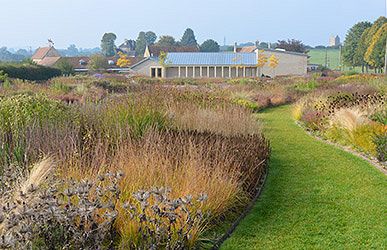
Piet Oudolf Field, Hauser & Wirth Somerset, 2017. Image: Josie Elias / Alamy Stock Photo
Like-minded projects by award-winning gardeners at the RHS Chelsea Flower show include:
- Silver Gilt Flora Award 2007 – Isabelle Van Groeningen and Gabriella Pape: The Daily Telegraph Garden
- Gold Medal 2012 – Sarah Price: The Telegraph Garden
- Best Show Garden 2022 – Lulu Urquhart & Adam Hunt: A Rewilding Britain Landscape
“Yes, they resemble Arrival of Spring, Woldgate, Jonathan,” I say. “Please explain what’s going on here.”
“What clients want now is something more natural. Most are bored by the raised geometric flower beds their parents favored. What has emerged is a New Naturalism. You can’t underestimate the growing ecological awareness. People are very into native species that support local wildlife and insects. And they don’t want something that just peaks in summer with a single bloom and then dies. It’s a year-round garden they’re after that captures the beauty of each season.”
“How very Hockney of them,” I say — though, it’s likely more synchronicity at work here than influence or intention. “But Oudolf isn’t English.”
“That’s true, he’s Dutch. He began his experimentation in the early ‘80s at the Hummelo nursery in Gelderland. But he’s a global sensation and his sensibility is changing the face of England. Some attribute his thinking to German garden traditions. And his most famous garden is the High Line in NY.”
“But really,” he continues, “Oudolf is the true heir of Capability Brown, the progenitor of the English landscape garden and even Gertrude Jeckyll — it is pronounced ‘Jeek-le,’ you should know — who is perhaps the most English of all. Maybe even Sissinghurst by Ursula Sackville-West and her husband — and you know how much I love that garden!”
WHAT CAME BEFORE
The Gardens of Versailles (1624)
Louis XIV used the grand gardens surrounding his palace at Versailles to symbolize his absolute power. The Sun King occupied the absolute center of this orderly universe. The elaborate, highly organized, and stately geometry was pure artifice and propaganda on a grand scale.

Image: Prisma by Dukas Presseagentur GmbH / Alamy Stock Photo
For more than a century, it was the gold standard even in Britain. The newly renovated formal Baroque gardens at Hampton Court — which were developed by Charles II and later William & Mary between 1660 and 1702 — clearly bear its influence.
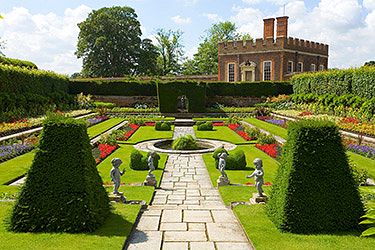
Image: Peter Phipp/Travelshots.com / Alamy Stock Photo
The English Landscape Garden
The English style that would unfold in the centuries to come arose in specific contradistinction to Versailles, as a symbol of the new constitutional monarchy, and the English national character. Instead of an imposing and regimented rectilinearity, it was all about elegant, sinuous curves over and through rolling hills, meadows, and fields — in many cases right up to the front entrance of one’s home.
What comes into focus is private property conceived as an intrinsic right of the landed gentry (rather than a privilege granted at the pleasure of the King). Land at this time was the source of all power and wealth. Parliamentary enclosure acts (1725-1860) widely encouraged the privatization of lands once in held in common. Thus wood, lawn, garden, and ponds all were conceived as one, to be wed together visually in sweeping vistas through a massive and all-encompassing reworking of the ground. For those who owned sprawling estates, it was de rigueur to gaze upon them and engage them through leisure activity and sport — even to have oneself portrayed as the master of one’s domain, with these views as backdrops. The common folk were, of course, disadvantaged by this scheme — which remains an issue to this day.
Lancelot Capability Brown (1716–1783)
The most influential and famous of all English landscape gardeners, Capability Brown largely pioneered the style and is widely known as England’s greatest gardener. Others played their part, too —notably William Kent (1658–1748) and Humphry Repton (1752–1818), known respectively for Chiswick House in London and Blaire Castle near Bristol, in addition to many other fine country house garden parks — but Capability remains the one who matters most.
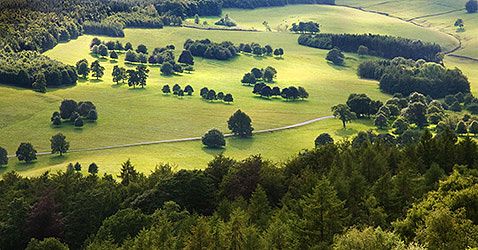
Image: Steve Taylor ARPS / Alamy Stock Photo
He was very hands-on in imposing an artificial naturalism upon the land, moving massive piles of earth to reshape its contours, planting large mature trees as focal points, redirecting the course of streams, building drainage systems to convert swampy bogs into picturesque pasture, and scattering architectural follies throughout — as at Croome Court in South Worcestershire, which is now owned by the National Trust and open to public visitors for a small fee.
THE ARTS AND CRAFTS MOVEMENT (1880 – 1920)
Gertrude Jekyll (1843-1932)
One of the premier influences for gardening enthusiasts of the 20th century and even now, Jeckyll in her time created over 400 gardens — most of which are now unfortunately gone — and penned more than a thousand articles. She took to gardening like a painter — as indeed she was trained as a child — focusing on the color, texture, and overall experience of her gardens with broad swathes of plantings, like brushstrokes, that were often viewed as Impressionistic. Turner was said to be an influence. And she was among the first to plan her gardens as pictorial compositions of warm and cool colors. Her signature soft herbaceous borders also allowed the scene to flow seamlessly from one passage to another.

Image: Martin Hughes-Jones / Alamy Stock Photo
But she is most closely identified with The Arts and Crafts Movement (most visibly represented by the architect Robert Morris), perceived as a radical club of socialists at the time, who championed time-honored traditions of craft in reaction to the impoverishment of the visual arts over the course of the Industrial Revolution. They — and she — were in some ways heirs to the Pre-Raphaelites: thus the tinge of Medievalism about their work.
Sissinghurst in Kent (ca. 1930s)
The most famous 20th-century garden in England is by Vita Sackville-West (at the site of her family’s ancestral castle) and her husband, the poet Harold Nicolson. First opened to the paying public in 1938, and thereafter more frequently, it was taken over by the National Trust in 1967 and in 2017 alone had as many as 200,000 paying visitors.

Image: Mieneke Andeweg-van Rijn / Alamy Stock Photo
It is well known that Sackville-West didn’t care for Jekyll’s herbaceous borders, but the thread of their aesthetic connection is plain for all the world to see. A novelist and poet of some acclaim, she was also a close friend and lover of Virginia Woolf. Her relationship with her husband was unconventional: both pursued multiple, mainly same-sex, affairs, giving the property iconic status in LGBTQ history.
“People have picnics in the parking lot at Sissinghurt,” Jonathan says, “right out of the backs of their cars. It isn’t asphalted over like the parking lots in America’s national parks — boundaries everywhere in England are porous, in the way that hedges are, for little animals and insects to live in. Even in walls, where stones are stacked without mortar. These marginal spaces, like Hockney’s roadside verge, are seen as vibrant living ecosystems.”
THE NEW ENGLAND OF DAVID HOCKNEY
“Traditional landscape gardens were famous for bankrupting their owners,” Jonathan continues.
“On one level, the New Perennial Movement is pragmatic. Clients are interested in something that requires less ongoing maintenance. On another, it is meant to feel as though they are not trying too hard.”
“But, in reality, to get that super casual effect, you can’t just let something go. Gardens like the High Line still need a lot of attention and regular watering. It is a studied wildness.”
“I love that,” I say. “Just like Byron’s hair, isn’t it?”
“But there’s another side to it, right?”
"Some want to see Hockney — for his earnest interest in the ephemeral effects of light and weather — as an English Monet."
"But there is something more wholeheartedly English about him," I insist.
Hockney doesn’t just extend and update the English landscape tradition for the 21st century. His populist eye deconstructs the whole of it — subverting its originary impulses in Capability Brown, its evolution into the picturesque and the sublime through Turner and Constable, the fantastic anachronisms of the Arts and Crafts movement — and perhaps most pointedly of all — the New Naturalist gardeners (i.e., the New Perennialists, Oudolf et al).
All the while, he offers a nod to each in turn — an homage even, with a wry, good-humored twist of pure joy. The Woldgate iPad drawings, for example, are invariably underscored by a subtle shade of wit in their very making.
HOCKNEY'S TWIN PRAGMATIC EPICS
At 15 x 24 feet, David Hockney’s Bigger Trees Near Warter, 2017 is the largest en plein air painting in history.
He laughed as he announced his intention to make something epic, "Do you think it's possible now to make landscape epic again...? I do." It wasn't clear at the time that this ambition was entirely appropriate to the current moment — what has landscape got to do with anything?
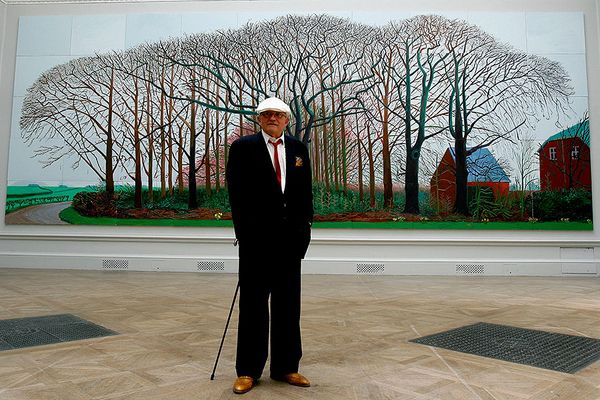
REUTERS / Alamy Stock Photo
In 2008, the artist donated the painting to the Tate.
He said, “I thought if I’m going to give something to the Tate, I want to give them something really good. It’s going to be here for a while. I don’t want to give things I’m not too proud of… I thought this was a good painting because it’s of England… it seems like a good thing to do.”
It subsequently starred in his legendary 2012 show at the Royal Academy.
One observer looking at the painting hailed it as a truly athletic achievement. He was blown away.
So was Damien Hirst, who more knowingly observed that Hockney made it look easy.
Hockney an athlete? Not so much. The septuagenarian artist himself was rightly proud to have invented a new combination of traditional painting and digital technology that enabled him to work on one of the fifty composite panels at a time, which was manageable for him. He sees it as more of a tactical accomplishment.
“Winston Churchill once said painting is a battle,” Jonathan laughs. “That’s never been more true than here.”
"There's more to it," I insist. "Did you see the show?"
Alongside that monumental painting in Bigger Trees at the Royal Academy, Hockney featured 51 iPad drawings from his Arrival of Spring, Woldgate series of 2011.
Presenting them in Gallery III — touted as the largest, grandest gallery of all — the RA billed this series of iPad drawings as the true centerpiece of its exhibition.
Hockney had worked fast to capture the essence of each scene on his iPad, then returned to Bridlington to work on it later in his studio — as he believes both Constable and Monet had also done by more conventional means.
Needless to say, the two bodies of work are inextricably linked.
Hockney is very comfortable with technology. He’d long engaged it — from cameras to office copiers — and he’d started this new chapter in the Yorkshire Wolds coming off a multi-year engagement with the optical technologies of the past, which had culminated in his 2001 publication of Secret Knowledge: Rediscovering the Lost Techniques of the Masters.
He’d also notably said of his earlier iPhone drawings that he could wake up, look out his window, and begin to work, without ever leaving the comfort of his bed. But those had been one-offs.
The Woldgate iPad drawings are relatively small in scale, but as a sustained endeavor, carefully observed, felt, and calibrated over several months, they are among his most epic. And nonetheless among his most pragmatic — at the same time.
This goes right to the heart of Pevsner, who identifies one of the most central strands of Englishness in the contrast between the soaring verticality of medieval sculpture and churches and the pragmatism of Hogarth. The pragmatic epic — Hockney nails it in a way no one else ever has before.
"In Post-war period people were still living in the shadow of the War. That — and the great British Empire — had been their epic and they were tired of all of it. It was time to divest."
“Rationing continued into the 1950s for a good decade after the War,” explains Jonathan. “At RHS Risely, then, they were planting regular rows of vegetables. It was an extension of the Dig for Victory movement during the War. Bear in mind, this is the Society’s premier garden venue. At that time, it was all very no-nonsense and practical.”
Despite Churchill’s enormous strength of character in helping to lead Britain to victory WWII, Labour’s vision prevailed in the years to come. Historic landed estates were taxed into oblivion. National Parks, which now welcome well over a 100 million visitors a year, only got their start in 1949 with passage of the National Parks Act. The first was formed in the Lake District in 1951. Nine others soon followed throughout the country — including The Yorkshire Dales National Park in 1954.
"Reading Bryson, one gets the feeling that maybe it's time for a new epic."
Bill Bryson, in Notes from a Small Island, hones in on British patience and tolerance for bureaucratic procedure. Though he hails from the American Mid-West, a BBC Radio 4 opinion poll for World Book Day in 2003 voted his book the one that best represented England. It is the cooperative communitarian spirit he addresses, most potently symbolized by “The Spirit of the Blitz.” He famously jokes that the Brits are even better at communism than the Russians.
“Practically speaking,” says Jonathan, “the biggest landscape issue in England now is public access.”
“Actually,” I respond, “the relationship of class politics and land go way back — but they’ve been making strides in England of late. I’m impressed. They’re ahead of us.”
A timeline on the right to roam:
- 1725–1860
Parliamentary enclosure acts cut people off from lands held in common.
- 1884–1932
Activists fight for the right to roam some private lands — mass rallies and trespasses are regularly held, including the important mass 1932 trespass of Kinder Scout in Derbyshire.
- 1939
The Mountain Access Bill passes. But clearly insufficient, it’s soon repealed.
- 1949
Legislation to start the National Parks includes improved access to the countryside.
- 2000
The Countryside and Rights of Way Act significantly extends the right to roam private lands in England and Wales.
Hockney’s father in the 1930’s is said to have had Communist sympathies. Though he was never a member of the Party, he strongly identified. One likes to think he would have been pleased.
HOCKNEY’S ENGLISH MOOD
“What do you make of the reticence here?” I ask Jonathan. “Are you seeing classic British reserve here…? Or perhaps something deeper?”
Blue is the dominant color in the artist’s LA pool paintings. Even the depths are lucid with sunlight, all the way down. Nor is it just the aqua of the water itself — there’s also the clear blue sky and cobalt-blue painted porch of his home in Malibu. Another of his early leitmotifs was the soft pink of the modernist little house in the Hollywood Hills. But, more and more frequently, as his LA work evolved, strident reds also started to appear in co-starring roles, not always attached to anything in particular.
In many of his Yorkshire Wolds paintings, Hockney similarly turns up the volume on color across the spectrum. Greens, while present in the LA compositions, were never this electric. And the reds, yellows, and fuchsias are now out in full force. Some people think he made the colors up out of his imagination — or simply brought them back home from LA. But the locals think otherwise, he’s proud to observe. The colors are there in the corn and rapeseed crops that ripen into vibrant hues in summer. He’s seen them. And these locals agree.
The Woldgate series — as a progression from winter to spring — is another thing entirely. The near total invisibility of green in the beginning is poignant, as verdant notes begin only slowly to emerge and then burst into a rich variety that is especially palpable. The human eye sees more different shades of green than any other color by far — and Hockney’s more than most. January through May — each moment seen in the context of the whole, moving from one state to another, becomes gloriously precious on its own. All of these works are special. The early works in the series are as reticent, nuanced, and soulful as anything in Hockney’s oeuvre.
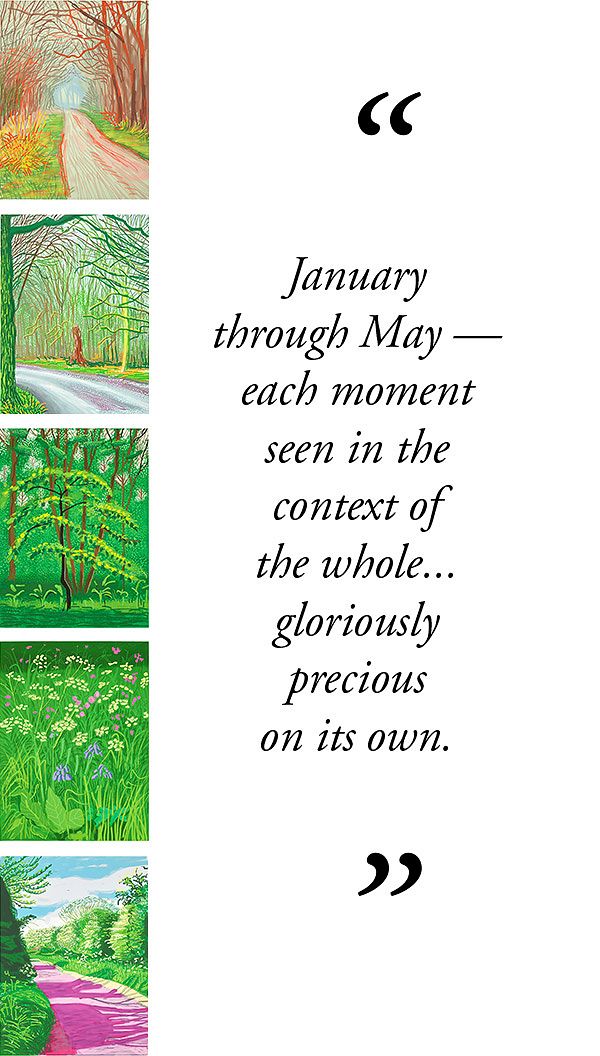
“England is a green country,” notes Jonathan, “far more than Los Angeles.”
“Very true. The artist claims, when he came to Yorkshire, he noticed the weather. England has weather. LA doesn’t.”
Hockney said, “The first spring I’d seen in 20 years was in 2002. I was sitting for Lucian Freud and I walked every morning through Holland Park. I noticed the spring and I thought: ‘Oh, it’s very exciting, this. Very exciting.’”
It was then he’d decided to paint it.
Fashion designer Bella Freud, the painter’s daughter, now looks to Hockney for inspiration on mood and color. “I became aware of him as another kind of painter,” she writes, “someone who was very connected to modern life as it was happening, in a very different way from my father.”
HOCKNEY'S YORKSHIRE
The Wolds of East Riding are not Hockney’s native Yorkshire. He is from Bradford, a very different place more than an hour to the west by car. He first encountered the Wolds in his young teens for six weeks each summer shooking corn at Foxcovert Farm in Huggate. He was travelling by bicycle back then, with a rucksack on his back. (He didn’t get a driver’s license until he moved to Los Angeles in 1964.)
“When I first came to the Wolds,” he remembers, “I cycled every-where and I quickly noticed the very beautiful cultivated landscape, so different from West Yorkshire and amazingly unspoiled.”
Hockney’s hometown Bradford is in the foothills of the Southern Pennines in the West, which is more closely associated with brooding romance of the craggy moors in Brontë country (think Wuthering Heights) and sublime majesty of the Yorkshire Dales brought to life in Turner’s epic landscapes. When locals refer to Yorkshire as “God’s Own Country,” it’s usually in reference to that.
The gently tolling chalk grasslands and fields of the Yorkshire Wolds, by contrast, scarcely received any attention at all before Hockney made them famous a decade ago.
He only reacquainted himself again many years later, in the summer of 1997, on his frequent drives through this country from his mother’s Bridlington home to visit his dying friend Jonathan Silver back in Bradford. It is this friend who had encouraged him to paint the Yorkshire Wolds, which had made him happy so many years ago.
NATIONAL CHARACTER AREAS
There are 159 different National Character Areas in England — each distinguished by a distinct biodiversity, geodiversity and economic activities. Not only are the geography, economy, and ecology completely different — so are their look and feel. Each of these three, which Hockney has often compared, represents a different version of England:
-
Southern Pennine Fringe, including the conurbation of Bradford and Leeds
Sandy gritstone layers intersperse with coal fields. The Bradford Beck is a valley famous for killing pea soup fogs during the Industrial Revolution when it supported the largest wool mills in the world. Development in this area is centrally planned under a greenbelt strategy to curtail and limit urban sprawl. Industry is now long gone. Once dirty and gloomy, as Hockney well recalls from his youth, it is now among the youngest, most ethnically diverse, and culturally vibrant cities in Britain. And its famous for its curry.
-
Yorkshire Dales
Long established as a Romantic and picturesque domain, much of it in 1951 became National Park. More recently, fashion model Amanda Owen set up here as a Yorkshire Shepherdess with her husband for a spectacular reality TV show, The Dales.
-
Yorkshire Wolds
An arc of low-lying calcareous chalk hills towards the northern frontier of East Riding that is now an almost entirely agricultural area of large farms. The intensification of arable crop farming in recent decades with chemical fertilizers and insecticides has dramatically reduced pasturelands and destroyed the rich diversity of native textured grasses, which now continue mainly on marginal areas of hedgerow and verge.
Additional notes on orientation:
-
The Wolds are within easy striking distance of Bridlington, where Hockney had bought a house for his mother and sister (and later came to reside himself).
-
Bridlington is the largest town in the area. Once a modestly fashionable seaside resort, the aging population makes it feel to many like a retirement community.
EXPERIENCING THE ENGLISH LANDSCAPE GARDEN
“When you plan a garden, you also think about how it’s going to be used,” says Jonathan. “That’s an important part of it?
“You mentioned the Woldgate Woods are harvested. Do they also have associations with leisure?”
“The verge is nature’s ‘picky tea.’ There’s nothing formal about it. But that’s just fine. People love that.”
A picky tea in the UK is when you spontaneously empty the fridge of leftovers and other random snacks for an indulgent carpet picnic.
“Bicycling and horseback riding are popular. There’s also a campsite nearby. And, increasingly, people drive these quiet country lanes to take in the picturesque scenery — the plants especially — which is always a big thing to do in the spring.”
Households in the UK with access to a car or van rose from 14% to 75% between 1951 and 2010. Most, in Hockney’s youth — including his own family — had relied on public transportation to get them out into the country, sometimes in combination with cycles. Even Harry Potter (as for example in his famous train ride through the Yorkshire Moors to the North). Hockney loves his Land Rover, of course. When he first settled in Bridlington, he would go on scouting trips with his assistant JP.
“That’s a characteristically British thing to do these days.”
“He started doing long road trips in the U.S. He set his local forays through California’s coastal mountains to music, as though he were making a movie,” I say.
“Many of the Yorkshire Wolds paintings feel like the frames of a scenic road movie.”
“Walking is another national pastime in the UK, even by the roadside — which one would never think to do in LA. It’s less about hiking, as in getting from point A to point B up the mountain in a hurry like Americans. They call it walking or rambling.”
In the UK, before the Industrial Revolution, walking out in nature was inherently suspect. One would have been seen as a vagrant, outlaw, or pauper. All that changed with the advent of the Romantic movement. Thomas West first popularized the activity of walking for pleasure in his 1778 guide to the Lake District. Wordsworth soon followed with long poems of his grand walking adventures. Coleridge and John Keats were not far behind. And Robert Louis Stevenson is among the most famous walkers of the 19th-century.
“And Walt Whitman in America.”
Hockney was a huge fan of Whitman, largely owing to his celebration of intensely romantic friendships between young men — he even used homo-erotically charged lines from Whitman’s poems in any number of his student paintings around 1960, including “I am he that aches with amorous love” (Leaves of Grass, 1867). That he was a walker would not have been lost on Hockney. He taps that kindred spirit once again these many years later in his Arrival of Spring, Woldgate, which are reveries very much of a like kind:
Here by myself, away from the clank of the world,
Tallying and talk’d to here by tongues aromatic,
No longer abash’d — for in this secluded spot I can respond as I would not dare elsewhere.
—Whitman, from "Paths Untrodden," 1867
In the interwar period in the UK, rambling clubs became wildly popular. Hockney’s own parents met on a Methodist outing. The great Evangelical Revival was still well under way in soot-strangled, working-class mill towns like Bradford. The great outdoors was seen as a way for younger people to enjoy fresh air and sunshine in the Edenic innocence of nature — and for older teens to escape the sinister influences of squalor and vice.
Such was the thinking behind the international Scouting movement, also, which was started there in 1908 by Lieutenant-General Robert Baden-Powell, a hero of the Boer War and 1st Baron Baden-Powell. The two were entwined for Hockney in his boyhood and early teens, as his Scout troop met out of the local Eccleshill Methodist church his parents attended — although his experience was less than innocent. He was a very mischievous boy.
-
Cubs – 8 to 10 ½ years
-
Scouts – 10 ½ to 14 years
-
The young David Hockney participated in both
Christopher Simons Sykes’ 2014 biography of David Hockney touches on this moment as the “stomping ground of the artist’s earliest sexual explorations” with tender conviction:
“When I was in the Boy Scouts,” says Hockney, “I used to be quite naughty, but you’d never talk about it. I mean, you’d put your hand on someone’s cock, but you’d never mention it later. I liked the camping because it was sexy. It was an opportunity to get into someone else’s sleeping bag. We were just kids, teenage boys messing around.”
“Or maybe quite innocent, after all,” says Jonathan.
“Some things you’d never talk about. Even in the pictures. That’s not to say it isn’t there.”
One feels a demure innuendo in Hockney’s contemplative reflections upon his past. The now predominates as always, yes, in these images, but it is the richness of his familiarity that informs his eye.
In 2002, Hockney saw the American Sublime show at Tate Britain. He dismisses Tomas Cole’s 1828 representation of the Garden of Eden as “bombastic, even operatic.” His alternative to Cole’s dark, Gothic gloom is “no shadows, no perspective, and no measurement,” restoring a primordial, childlike innocence to the subject in a series of light-handed watercolors that year, filled with light and color. It is this spirit that again comes to the fore in the Arrival of Spring, Woldgate nearly a decade on.
Another of Hockney’s early experiences of the woods that is more truly Edenic was frolicking along the grassy meadows and verges with his siblings on the outskirts of Eccleshill as his mother collected wild herbs and salad greens to supplement their meagre rationed allowance during the War and after. She was a vegetarian — a practice the artist would also later embrace as a theme in his art school years.
Graduating from Bradford School of Art in 1957, Hockney did two years of national service as a conscientious objector, attending to the sick as an orderly at St. Luke’s Hospital in Bradford and St. Helen’s in Hastings. In addition to painting the industrial landscape of Bradford during this time, he spends 18 months poring over Marcel Proust’s À la Recherche du Temps Perdu (Search for Lost Time). Years hence, finding retrospective solitude in the Woldgate Wood, pulled over in his Land Rover along the verge to execute Arrival of Spring, he similarly encounters a feast of untold riches.
WOLDGATE PAST AND FUTURE
Peter Ackroyd’s now classic tome Albion, 2002 imagines the entire cultural history of England from ancient times to the present day — including Turner and Constable — as a spirited feat of imagination originating in the Druidic worship of trees. As one reader noted, Ackroyd is less keen to see what is Modern about Anglo Saxon culture than what’s Anglo-Saxon about Modern English Culture; but see it he does — everywhere, as “a native spirit that persists through time and circumstance.”
These images are my first encounter with Woldgate. To my ear, the name evokes a grand medieval forest or even something more towering and ancient. “Wald” in Middle English originally meant just such a thing. All of Britain once teemed with trees. But, on the map, you’ll see this is only the merest speck of a roadside wood, a lonely and timid thing set amidst an endless patchwork expanse of farmers’ fields.
My gut instantly decries this deforestation as a criminal act. But, the Yorkshire Wolds were cleared well before the Romans had even arrived, all the trees cut down by the native Brigante tribes who ruled these parts in the Iron Ages.
The meaning of the English word evolved over the centuries with the terrain it described to become closer to the sense of treeless, rolling meadows. A more likely derivation is from the Swedish word “vall,” which always indicated a pasture. Yorkshire was part of the Danelaw, ruled in the Late Medieval Age by Vikings. “Gate” too is a Viking word that simply means road. So the name Woldgate means road through the pasture, which is apt.
The most important tree in the Wolds is the Ash. The Woodland Trust — which is the UK’s largest woodland conservation charity — maintains a registry of important Ash trees based on a three-tier classification system:
- Ancient - 225 years or older and 4–5m in girth
- Veteran - Typically 100–200 years and more than 3.25m in girth
- Notable - Trees of cultural or historical value (prominent position in the landscape or evidence of pollarding.
Take note: Ash trees don’t just get bigger as they age. Their entire character changes. The bark, at first smooth in new-growth trees, becomes more fissured with age. They often develop fungal fruiting bodies, like the giant warts on a witch’s nose. The trunks thicken into twisting muscular masses that later hollow and become riddled with boreholes and decay. They often come to host secondary epiphytic species of plants that get their water from the air rather than from roots in the soil. This is what you see in Hockney.
What in America are called old-growth forests or virgin forests are officially designated in England as “Ancient Forests.” That means a woodland that has existed continuously since 1600. Before that, it is presumed people didn’t plant forests, so that it is considered to be natural. Notably, Ancient Woodlands are few and far between. By American standards, they are also tiny.
The city of Bridlington, which has jurisdiction here, commits to mowing the grasses on the verge once a year. That seems to be about the extent of their involvement. This is to keep the seedlings from growing up to obscure the road and the roots from digging down underfoot to upturn the paving. It is less about creating a pleasant sidewalk for pedestrians.
“Those Woldgate Woods,” says Jonathan, “look to have just sprung up on their own without any assistance. It is definitely not an Ancient Forest. Whoever owns that plot of land — finding out who owns a piece of ground in England is always tricky business — appears to be harvesting for ash timbers of late, but my bet is that the seeds just blew from a veteran tree in a hedgerow several generations ago onto a fallow field — and it was just left untended. England is very wet. Things grow.”
Someone recently cut down Hockney’s famous “Fetish” (the ancient stump). No one seems to know who or why.
“Particularly in the 20th century, the government has been very involved in afforestation projects — that means planting forests. After the British depleted their timber reserves to dangerous levels fighting the first World War, the newly-minted Forestry Commission went on a massive tree-planting binge. But what a disaster, especially in the Lake District, where they planted row after row of fast-growing trees as a lumber resource! People felt —and rightly so — it was destroying all the beautiful vistas.”
“That the government planted mainly non-native species like larch was less of an issue then than it is now. And people like to be more involved in the planting themselves. More and more, they are taking ownership.”
“Ecology is a major issue now,” Jonathan continues. “The ash trees in so many in these pictures are in the midst of a massive die-off all across the country. Even in America — but the tree is much more common and typical in England. The face of England will soon change forever.”
The ‘HEYwoods Initiative’ in East Yorkshire has prescribed a planting regimen to nip the problem in the bud. It emphasizes the planting of species indigenous to the region, including Field Maple, Sycamore, Grey Alder, Wild Cherry, Whitebeam, and Yew. So all is not lost.
“Which in a way,” I add, “makes Hockney something of a history painter, too.”
“British reserve?” says Jonathan. “Did you catch those plastic, bright yellow Crocs he sported at King Charles’ first luncheon for the Order of Merit back in November? He’s definitely still got it.”
Hockney was awarded membership in the prestigious Order of Merit in 2012. He has also been championed as a fashion icon for decades. (Vogue had particularly loved his LA casual studio look of striped rugby shirt and canvas Plimsolls, stripped of their laces — riffs on British themes.) The Crocs were a Hockney twist on the traditional Yorkshire farmer’s wooden soled clogs, just as surely as the white linen cap he wore throughout his Wolds painting adventures is a witty spin on the traditional wool tweed Yorkshire flat cap. He’s gone native, yes, but very much of his own way. “Beautifully chosen,” King Charles famously said — he being himself a keen fan of the country look.
About Jonathan Keep
Our gardening informant founded the firm Jonathan Keep Landscape Design in 2001, after receiving his Masters in Landscape Architecture from Harvard. He grew up on a farm in Pennsylvania, escaping chores to explore surrounding quarries, streams, and woods — and is now based in Lincoln, Massachusetts on the rural outskirts of Boston. Among his many successes, Jonathan supervised a horticulture program at the Devereux Foundation based on E. O. Wilson's Biophilia Hypothesis which was awarded Garden Design Magazine's Golden Trowel Award for 'Best Healing Garden.'
Auction /
18 – 19 January
30 Berkeley Square, London, United Kingdom, W1J 6EX (map)
Viewing /
11 – 18 January
Monday-Saturday 10:00am-6:00pm GMT
Sunday 12:00pm-6:00pm GMT
Discover More from Editions London >
Recommended Reading
Eternity in the Present: Whitehot's Noah Becker on Alex Katz >
